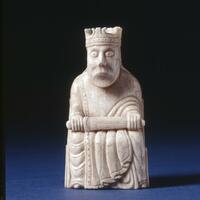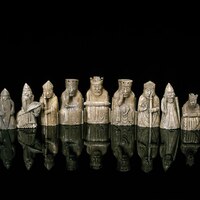Lewis Chessmen
Type:
Game pieces
Date:
ca. 1150–1200
Location or Findspot (Modern-Day Country):
United Kingdom,
Norway
Medium:
Ivory
Dimensions:
60–100 mm
Description:
The Lewis Chessmen (sometimes called the Uig Chessmen) were carved from walrus ivory (and a few from whale teeth) in a Nordic country, most likely Norway. They represent the largest group of European chess pieces. They were discovered in 1831 on the Isle of Lewis in Scotland's Outer Hebrides, an island chain under Norse control when these gaming pieces were made. The carved figures appear seated (king, queen), standing (mitered bishop, warder), or sometimes riding horses (mounted knights). The pawns are smaller obelisks.
Relevant Textbook Chapter(s):
8
Repository and Online Resources:
• The British Museum (London) owns 82 chess pieces.
• The National Museum of Scotland (Edinburgh) owns 11.
• Listen to a podcast on the Lewis Chessmen in the BBC series, "A History of the World in 100 Objects."
• Read about a newly rediscovered and auctioned chess piece.
Image Credits:
© The Trustees of the British Museum; National Museum of Scotland






